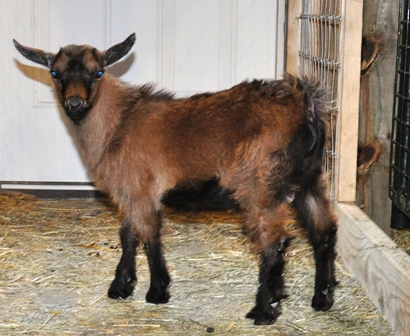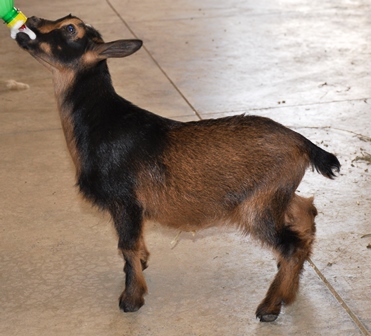Many goat-herd owners choose not to keep bucks because they’re only needed to breed the does once a year, it takes time and money to feed and maintain them year round, and they can have a strong 
I’m interested in breeding polled (naturally hornless) goats; but because of an article written in 1944 that linked polled goats to increased rates of hermaphrodism (animals with both male and female organs that are sterile), there are very few good polled goats around. After that article was published, most polled goats were either destroyed or hidden. That articles validity has been questioned recently (many claim that there’s no statistical difference in the rates of hermaphrodism between polled and horned goats) and interest in polled goats seems to be increasing.
But that all meant that if we really wanted to work with polled goats, we had to commit to getting a polled buck. I’ve been admiring the Nigerian Dwarf goats at Old Mountain Farm for a long time (and already have a doe from there – 3*M Old Mountain Farm Hot Tea 3*D), so I inquired. And, they had two handsome brothers available.

While there, since it’s such a long drive, we also picked out a doeling to bring home. It was difficult to make the choice, but in the end we came home with Field Mouse (aka Mighty – pic on the right) and Taylor Quinn (Taylor – pic on the left). I’m very excited to add these two goats to the Bramblestone herd – they’re both very correct (in dairy conformation), have gorgeous dams & handsome sires, and are beautiful examples of good breeding.
Taylor is six weeks old tomorrow, so she still gets a bottle once a day, while Mighty is 8 weeks old and fully weaned. In coloration, Taylor is a reddish gold and black buckskin while Mighty is a chamoise. These colors and coat patterns are very common in the Nigerian Dwarf breed, and I think some of the most beautiful. I need to get better pictures, but I’m very happy to have them here, and can’t wait to see them mature. Hopefully we chose well, because as the first herdsire, Mighty is going to have a big impact on the herd for a long time.
Lesa says
Jessimond, 4 yrs. is certainly too long so she probably is, but I’m no expert on hermaphrodism. I sure agree with you on the ND’s, really love them and their milk. We’re breeding for milk production, dairy conformation, and naturally polled – sorry but no blue eyes or wattles 🙂
Lesa says
Thanks Sheila & Janet, it will be a new experience from here – they are pretty gorgeous looking to me too!
Jamie Collins says
Awesome! They are both beauties! Best of luck to you in your endeavors. We are currently considering an Old Mountain Farm buck to use as a stud this year too.
jessimond2013 says
LOVE THIS! We have a tiny herd of (mostly) Nigerian Dwarf goats. For the very reasone stated at the beginning of your post, we do not currently have a buck of our own, but had a “loaner buck”. I strongly suspect my one pricey doe to be a hermaphrodite as she is four years old and has never shown ANY signs of coming into season. I would like to learn MORE about this condition if you have any references you’d care to share. My one “nanny” is only half ND and we suspect her sire was a fainter because she gets the classic wooden-leg symptoms when startled! Our third doe is a naturally polled high-percentage Boer. She was given to us by friends because she was the runt from a kidding of triplets and they were afraid to allow he to be bred by their large bucks because at age two she was still only about the size of my ND’s! She has grown quite a bit since then, mostly in the legs, and she is so very sweet that I let her stay in the main pen with our visiting buck. I’m interested to see IF she has any kids if they, too, are polled!
WHEN we finally get around to getting a buck of our own, I know I want a really good Nigerian Dwarf, as they are still the breed I prefer. I did lots of breed research before purchasing our first goats and I truly love my ND goats! Their splashy colors and personalities are a bonus to their small size and temperament. Their milk is also quite deliciuos! Ideally, I’d love to breed for naturally polled goats, with blue eyes and waddles!!! Do any of your goats have waddles?
I sincerely look forward to hearing from you! Respectfully, Patricia Emery
Janet says
Wonderful choices! I am glad your trip was safe and successful. Thanks for the update, as we were waiting to hear how things went
Sheila Menendez says
Wonderful new babies! I’m sure you chose well – between your experience, research, and instinct – these two are gorgeous!